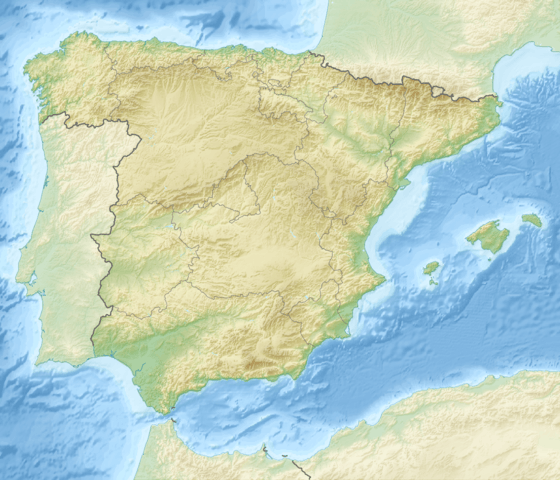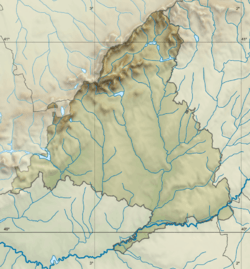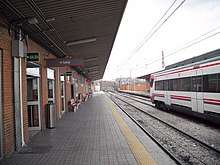Móstoles
Móstoles (Spanish pronunciation: [ˈmostoles]) is a city and municipality of Spain located in the Community of Madrid. With over two hundred thousand inhabitants, it is the region's second most populated municipality after Madrid. Móstoles was for a long time a small village, but expanded rapidly in the second half of the 20th century.
Móstoles | |
|---|---|
.jpg) | |
.svg.png) Flag  Coat of arms | |
 Móstoles Location in Spain  Móstoles Móstoles (Community of Madrid) | |
| Coordinates: 40°20′0″N 3°52′0″W | |
| Country | Spain |
| Region | Community of Madrid |
| Government | |
| • Mayor | Noelia Posse (PSOE) |
| Area | |
| • Total | 45.36 km2 (17.51 sq mi) |
| Elevation | 660 m (2,170 ft) |
| Population (2018)[1] | |
| • Total | 207,095 |
| • Density | 4,600/km2 (12,000/sq mi) |
| Demonym(s) | Mostoleños, Mostolenses, Mostoleros |
| Time zone | UTC+1 (CET) |
| • Summer (DST) | UTC+2 (CEST) |
| Postal code | 28930 - 28939 |
| Website | www.mostoles.es |
The city also hosts the main campus of the Rey Juan Carlos University.
Geography
_Madrid_ESA354454_(cropped).jpg)
The municipality presents a largely flat relief.[2] The main hydrographic features are the Guadarrama river at the western end of the municipality and several of the latter's left bank tributary creeks, including the Arroyo del Soto and the Arroyo de los Combos.[2]
It lies at 660 metres above sea level.[3]
History
It was founded most probably circa 1085–1137, after the Christian seizure of the Kingdom of Toledo (1085) as it was not mentioned in the chronicles compiling the villages seized in the conquest.[4] Written mentions to the village in the Middle Ages, since its foundation up to the late-15th century are limited.[4] By the beginning of the 16th century, it was part of the Land of Toledo.[5]
Móstoles became famous as, although it was only a small village, its municipal authorities called for a general rebellion against the French forces on 2 May 1808 immediately after the Dos de Mayo Uprising in the Spanish capital, reportedly issuing the following public announcement (bando) signed by the Mayor: "The homeland is in danger. Madrid is perishing, victim of the French perfidiousness. Spaniards, turn to save her".[6]
The municipality experienced a slow and steady population growth during the first half of the 20th century, followed by a huge demographic expansion from the 1960s onwards.[7]
Main sights
Historical landmarks
Two of the most architectural landmarks in Móstoles are churches; the church of La Asunción de Nuestra Señora (whose construction dates back to the 13th century) features a Mudéjar apse.[8] The Baroque hermitage of La Virgen de los Santos dates from the 17th century.[9]
There is a sculpture by Aurelio Carretero paying homage to Andrés Torrejón inaugurated in 1908 to mark the one hundredth anniversary of the Dos de Mayo uprising.[10]
Museums and galleries
_5.jpg)
Móstoles is the home of the Community of Madrid's modern art gallery, the Centro de Arte Dos de Mayo (CA2M). It was opened in 2008 to mark the two hundredth anniversary of the Dos de Mayo uprising.[11]
The residence of Andrés Torrejón was rehabilitated by the city council and turned into a museum.[12]
Transportation

Móstoles is connected to other suburbs and to central Madrid by:
- several major freeways (A-5 (Madrid-Badajoz-Lisbon), M-50) and toll highways (R-5).
- local and regional bus lines
- the Metrosur line (line 12, Madrid Metro)
- a commuter train line (line C-5, Cercanías Madrid) which has a terminus in Móstoles.
Walking and cycling
There is cycling infrastructure (Spanish: aceras bici, "bike-sidewalks") within central Móstoles. Funds were made available in 2017 to upgrade these cycleways.[13]
It is also possible to cycle into the nearby countryside. The railway line originally continued to Almorox, but the section beyond Móstoles was closed in the 1960s. Between Móstoles-El Soto railway station and Navalcarnero the track has been converted into a greenway (via verde) for cyclists and walkers. The route crosses the river Guadarrama on an iron bridge.[14][15] The via verde connects to a waymarked long distance walk to Guadalupe in Extremadura. The waymarking is recent, but it marks a traditional route from Madrid to the Our Lady of Guadalupe pilgrimage site.[16]
Notable people
- Iker Casillas, former professional goalkeeper, who played for Real Madrid, F.C. Porto and the Spain national football team.[17]
- Rubén de la Red, footballer[18]
- Alberto Lora, footballer[19]
- Rafael Martínez, gymnast
- Christian Gálvez, actor and TV presenter[20]
- Raúl Arévalo, actor[21]
- Rubén Belima, footballer[22]
- Las Supremas de Móstoles, a popular singing pop band made up of three sisters
References
- Citations
- Municipal Register of Spain 2018. National Statistics Institute.
- Martín-Serrano García 2004, p. 177.
- "Móstoles". AEMET.
- Martín-Serrano García 2004, p. 179.
- Martín-Serrano García 2004, p. 180.
- Martín-Serrano García 2004, p. 185 "La patria está en peligro. Madrid perece víctima de la perfidia francesa. Españoles, acudid a salvarla."
- Martín-Serrano García 2004, p. 192.
- Martín-Serrano García 2004, pp. 254–255.
- Martín-Serrano García 2004, p. 261.
- Medialdea, Sara (5 May 2008). "El monumento al alcalde de Móstoles cumple cien años". ABC.
- Fanjul, Sergio C. (23 February 2018). "Arte contemporáneo con memoria". El País.
- "Móstoles recuerda a su heroico alcalde, Andrés Torrejón, con motivo del bicentenario de su muerte el 17 de agosto". Teleprensa. 13 August 2012.
- EFE (26 September 2017). "Móstoles pone en marcha proyecto de Rehabilitación de todas las Aceras Bici". La Vanguardia (in Spanish). Móstoles. Retrieved 6 May 2018.
- "Vía Verde del Guadarrama" (PDF). Comunidad de Madrid (in Spanish). Retrieved 6 May 2018.
- "Guadarrama River Greenway". Vías Verdes. Fundación de los Ferrocarriles Españoles. Retrieved 6 May 2018.
- "Camino Real a Guadalupe. Etapa 2. Móstoles – Casarrubios del Monte". Wikiloc (in Spanish). 19 July 2012. Retrieved 6 May 2018.
- "Iker Casillas". Hola! (in Spanish). Retrieved 23 September 2018.
- Calderón, J. L. (4 April 2016). "De la Red regresa al lugar donde volvió a nacer". Marca (in Spanish). Unidad Editorial Información Deportiva, S.L.U. Retrieved 23 September 2018.
- Rodríguez, Pelayo (23 March 2018). "Alberto Lora, uno di noi". Vavel (in Spanish). Retrieved 23 September 2018.
- ""La mitad de mi sangre me tira hacia La Línea"". Europa Sur (in Spanish). Joly Digital. 16 July 2010. Retrieved 23 September 2018.
- Álvaro, Carlos (18 May 2017). "Raúl Arévalo presume de raíces segovianas en un vídeo para agradecer el Premio Diputación". El Norte de Castilla (in Spanish). Vocento. Retrieved 23 September 2018.
- Banderas, Miguel Ángel (22 November 2013). "La Fábrica: Rubén Belima". Vavel (in Spanish). Retrieved 23 September 2018.
- Bibliography
- Martín-Serrano García, Pilar (2004). "Móstoles". Arquitectura y desarrollo urbano Comunidad de Madrid (Zona Sur) (PDF). XII. Madrid: Dirección General de Arquitectura y Vivienda & Colegio Oficial de Arquitectos de Madrid. pp. 173–282. ISBN 84-451-2698-9.CS1 maint: ref=harv (link)
